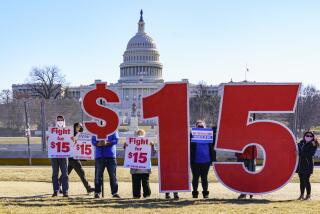Study Cites Widespread Poverty in U.S.
- Share via
WASHINGTON — Poverty in the United States was more widespread, severe and long-lasting during the 1980s than it was in other Western democracies, according to a study released Wednesday by a Washington public policy research group.
Although the numbers of poor people rose during the past decade in most of the seven countries studied, the United States did the least to help its poor, the report by the Joint Center for Political and Economic Studies concluded. The center is a nonprofit advocacy group that concentrates on issues involving black Americans.
The federal government provides financial assistance to poor families, but the benefits are more than offset by the federal taxes they must pay, the study said. As a result, the combined effect of current tax and public assistance policies does not reduce the number of U.S. families considered poor, it said.
“The findings should be deeply disturbing to the American public and American policy-makers,” said Katherine McFate, a senior research associate at the center.
The organization said the findings demonstrate the need for expanded public welfare programs in the United States. But another Washington research group questioned the study results and methodology, noting that the definition of poverty was different from the one used by the federal government.
Although the United States had higher economic growth rates and lower unemployment than the other countries during the 1980s, the percentage of households in the United States defined as poor was substantially higher, according to the calculations used by the center.
In the United States, 18.1% of households headed by 20- to 55-year-olds fell below the poverty line in 1986, the study said. That contrasts with mid-1980s estimates of 13.9% in Canada, 12.5% in Great Britain, 9.9% in France, 8.6% in Sweden, 7.6% in the Netherlands and 6.8% in what was then West Germany.
The study defined the poverty line as 50% of each nation’s median income after taxes and public assistance payments. In the United States, that translates to a $15,000 annual income for a family of four, said Lee Rainwater, a Harvard University sociology professor who worked on the study.
The federal government does not use median income statistics to determine its poverty standard. The government’s official poverty line, which varies according to family size, was $11,203 for a family of four in 1986.
The federal government estimated the poverty rate that year at 10.9% of families, considerably less than the center’s estimate, said Marvin Kosters, director of economic policy studies at the conservative-leaning American Enterprise Institute.
“This is a kind of advocacy piece intended to make a point that there are lots of people and families below the poverty line and that something needs to be done,” Kosters said.
Although the center’s study found that the net effect of U.S. tax and public assistance programs lifted no poor households out of poverty, it said government programs in Great Britain, the Netherlands and France pulled more than half of poor households above the poverty line.
Study organizers said the United States should follow the example of European welfare systems in providing more child-support payments for single-parent households, which often are among the poorest. Rainwater said the United States also should expand insurance for unemployment, health and maternity. Those types of insurance generally are more prevalent in European countries, Rainwater said.
More to Read
Sign up for Essential California
The most important California stories and recommendations in your inbox every morning.
You may occasionally receive promotional content from the Los Angeles Times.













